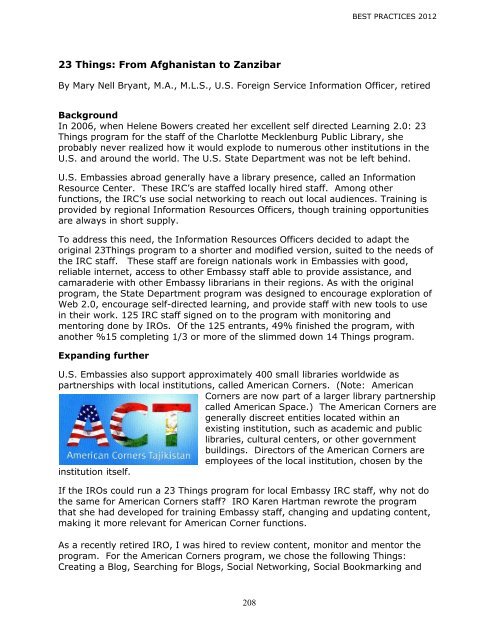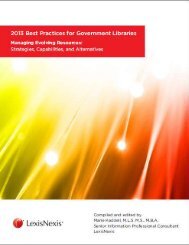2012 Best Practices for Government Libraries
2012 Best Practices for Government Libraries
2012 Best Practices for Government Libraries
You also want an ePaper? Increase the reach of your titles
YUMPU automatically turns print PDFs into web optimized ePapers that Google loves.
23 Things: From Afghanistan to Zanzibar<br />
208<br />
BEST PRACTICES <strong>2012</strong><br />
By Mary Nell Bryant, M.A., M.L.S., U.S. Foreign Service In<strong>for</strong>mation Officer, retired<br />
Background<br />
In 2006, when Helene Bowers created her excellent self directed Learning 2.0: 23<br />
Things program <strong>for</strong> the staff of the Charlotte Mecklenburg Public Library, she<br />
probably never realized how it would explode to numerous other institutions in the<br />
U.S. and around the world. The U.S. State Department was not be left behind.<br />
U.S. Embassies abroad generally have a library presence, called an In<strong>for</strong>mation<br />
Resource Center. These IRC’s are staffed locally hired staff. Among other<br />
functions, the IRC’s use social networking to reach out local audiences. Training is<br />
provided by regional In<strong>for</strong>mation Resources Officers, though training opportunities<br />
are always in short supply.<br />
To address this need, the In<strong>for</strong>mation Resources Officers decided to adapt the<br />
original 23Things program to a shorter and modified version, suited to the needs of<br />
the IRC staff. These staff are <strong>for</strong>eign nationals work in Embassies with good,<br />
reliable internet, access to other Embassy staff able to provide assistance, and<br />
camaraderie with other Embassy librarians in their regions. As with the original<br />
program, the State Department program was designed to encourage exploration of<br />
Web 2.0, encourage self-directed learning, and provide staff with new tools to use<br />
in their work. 125 IRC staff signed on to the program with monitoring and<br />
mentoring done by IROs. Of the 125 entrants, 49% finished the program, with<br />
another %15 completing 1/3 or more of the slimmed down 14 Things program.<br />
Expanding further<br />
U.S. Embassies also support approximately 400 small libraries worldwide as<br />
partnerships with local institutions, called American Corners. (Note: American<br />
Corners are now part of a larger library partnership<br />
called American Space.) The American Corners are<br />
generally discreet entities located within an<br />
existing institution, such as academic and public<br />
libraries, cultural centers, or other government<br />
buildings. Directors of the American Corners are<br />
employees of the local institution, chosen by the<br />
institution itself.<br />
If the IROs could run a 23 Things program <strong>for</strong> local Embassy IRC staff, why not do<br />
the same <strong>for</strong> American Corners staff? IRO Karen Hartman rewrote the program<br />
that she had developed <strong>for</strong> training Embassy staff, changing and updating content,<br />
making it more relevant <strong>for</strong> American Corner functions.<br />
As a recently retired IRO, I was hired to review content, monitor and mentor the<br />
program. For the American Corners program, we chose the following Things:<br />
Creating a Blog, Searching <strong>for</strong> Blogs, Social Networking, Social Bookmarking and



